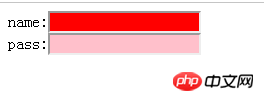
What is a css selector? The css selector specifies the tag that CSS should act on, and the name of that tag is the selector. Meaning: Which container to choose. Elements in HTML pages are controlled through CSS selectors. So, what are the css selectors? Let’s take a look at the commonly used selectors in css
1: css wildcard selector
The wildcard selector is represented by an asterisk (*), for example:
*{ font-size : 12px; }
means that the font size of all elements is 12px;
2: css group selector
When several elements have the same style attributes, you can Called together into a statement, elements are separated by commas. For example:
p, li { line-height:20px; color:#c00; } #main p, #sider span { color:#000; line-height:26px; }
Using the group selector will greatly simplify the CSS code. Elements with multiple identical attributes can be merged into groups for selection, and the same CSS attributes can be defined, which greatly improves coding efficiency. It also reduces the size of CSS files.
3: css tag selector
A complete HTML page is composed of many different tags, and the tag selector determines which tags use the corresponding CSS style, for example:
p{ color: red; }
This code will make all p tags turn red
4: css class selector
class The selector targets any element with the specified class name in the class attribute. The class selector starts with a "." symbol. For example:
.info { color:black; }
This will change the color of all elements with the class name info. Is black
5:css ID selector
The ID selector can specify a specific style for the HTML element marked with a specific ID; the ID selector starts with a "# ” symbol begins. For example:
#demop{ color:#000; }
This means that the font color of the element with the id demop is set to black.
6: css pseudo-class selector
Sometimes it is necessary to apply the style of an element using other conditions outside the document, such as mouse hover, etc. At this time we need to use pseudo classes. The following is the pseudo-class definition for the linked application. For example:
a:link{ color:green ; font-size: 50px } a:hover{ color:pink; font-size: 50px } a:active{ color:yellow; font-size: 50px } a:visited{ color:red; font-size: 50px }
Effect:
The label is green when the web page is opened
The label is pink when the mouse is placed on the label
The label is yellow after clicking the label
The label is red after clicking .
7: css descendant selector
The descendant selector is used to select the descendants of a specific element or element group. The selection of the parent element is placed in front, and the selection of the child element is placed first. The selection of elements is placed at the end, separated by a space. There can be more than just two elements in the descendant selector. For multi-level ancestor-descendant relationships, there can be multiple spaces to separate them. For example, if there are three elements with IDs a, b, and c, the descendant selector can be written as #a In the form of #b #c{}, as long as the selection of ancestor elements is separated by spaces before and in the middle of descendant elements. For example:
#people em{ color: red; }
This rule sets the color of any em elements contained in elements with the ID value "people" to red.
8: css combined selector
can combine two or more types of selectors; for example:
p.info { color:blue; }
It only Select paragraphs that belong to the info class. Other elements that belong to this class and other paragraphs that do not belong to the info class will be ignored.
9: css attribute selector
Format: Basic selector [attribute = 'attribute value']{ }, you can also just write attributes, for example:
Run results:
css selector priority size:
!important > Interline style>ID selection Selector> Class|Attribute Selector> Tag> Wildcard> Inheritance> Browser Default Attribute
When there are some complex selectors that cannot be selected by the priority size ratio, then we will use it Weight calculation
css selector weight calculation:
| Infinity |
Interline Style |
| ID Selector | |
| Class|Attribute|Pseudo-class selector | |
| Tag selector | |
| Wildcard Selector
| 0
Convert all selectors on each line into these values and add them up. The larger the result, the higher the priority! Recommended related articles: css class Selectors and id selectors Related course recommendations: |
The above is the detailed content of What is a css selector? Summary of basic css selectors (nine types). For more information, please follow other related articles on the PHP Chinese website!




